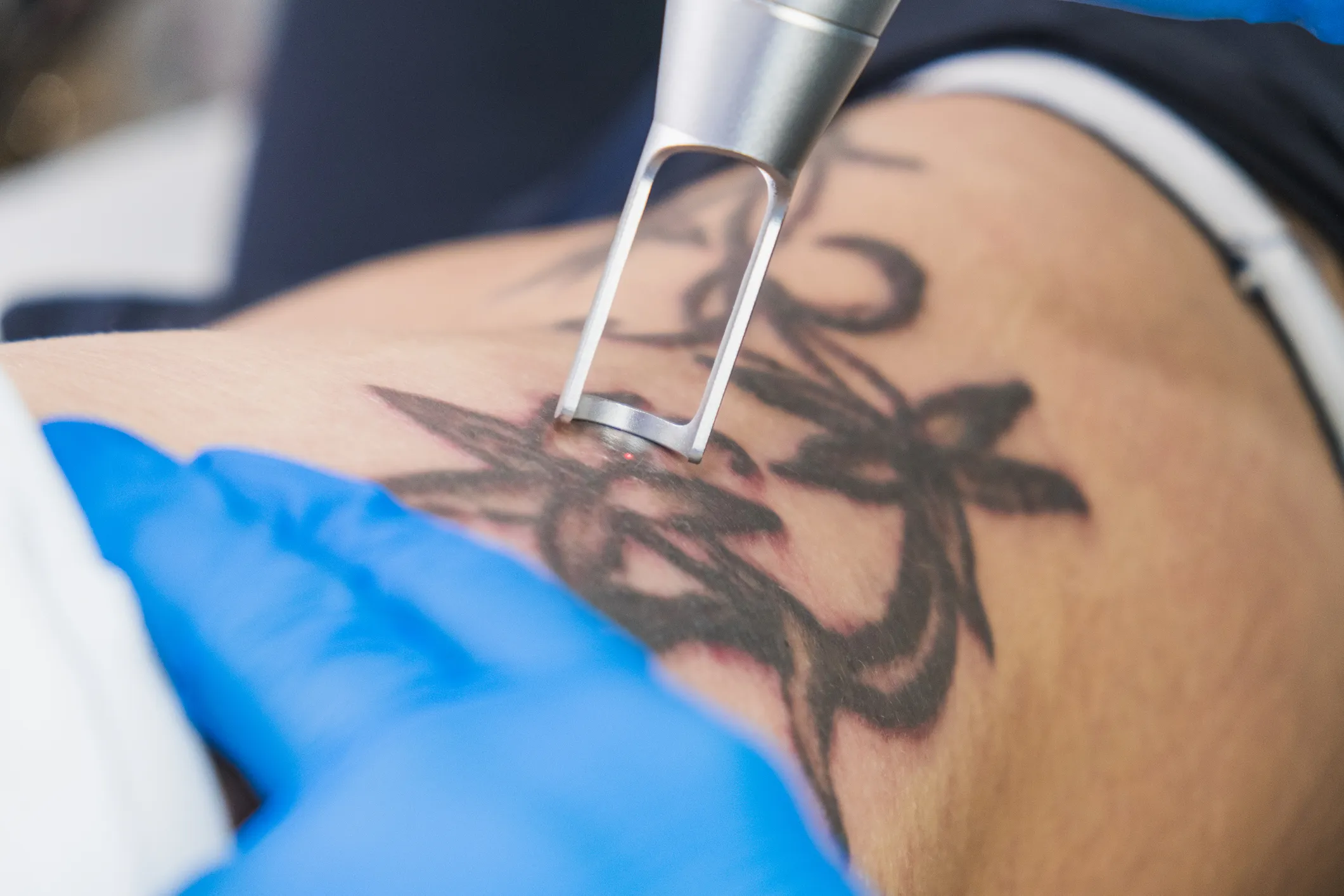Let’s face it, tattoo removal is probably one of the last things you’re thinking of when you sit down to get a new tattoo. But not every piece of art that gets inked ends up staying with a person forever.
Some of the most common reasons for tattoo removal are job requirements, a change in personal taste or style, dissatisfaction with the tattoo’s appearance or placement, or a change in personal circumstances such as the end of a relationship or the name of a loved one. Some people may even seek removal due to an allergic reaction or skin irritation caused by the tattoo.
 pedro arquero/Getty
pedro arquero/GettyIf one of the above conditions applies to you and you find yourself wanting to lighten or completely remove a tattoo, here’s what you need to know before you consider tattoo removal:
What To Expect
The tattoo removal process can take several weeks to several months, depending on the size, color, and location of the tattoo. The tattoo may become lighter after each treatment but may not completely disappear. Some tattoo pigments are more resistant to removal than others, and some colors may not be completely removed. You may experience some pain or discomfort during the removal process, and you may also experience some side effects such as redness, swelling, and blistering.
Find a Reputable Provider
Here are some tips to find a reputable tattoo removal professional:
- Research and compare different options: Look for medical spas, dermatologists, or laser clinics that specialize in tattoo removal.
- Check their credentials: Make sure the facility and practitioner are licensed and certified. Look for reviews and ask for recommendations from friends or family members who have had tattoos removed.
- Schedule a consultation: A reputable professional will be happy to answer your questions and address any concerns you have before starting the removal process.
- Ask about the removal process: Find out what type of equipment they use. Also, ask about the number of treatments required, pain management, and aftercare instructions.
- Consider the cost: Compare prices and make sure the facility is transparent about the total cost of removal. Some facilities may offer financing options.
How To Prepare
Once you’ve found a provider to remove your tattoo, there are a few things you’ll want to do to make sure you’re prepared when the day arrives:
- Avoid direct sun exposure and tanning for several weeks prior to the removal procedure.
- Stop using any creams or ointments that may irritate the skin, as well as any blood thinning medications (such as aspirin) a few days before the removal.
- Provide the tattoo artist or dermatologist with a detailed history of the tattoo, including when it was applied, the type of ink used, and any previous attempts at removal.
- Wear loose, comfortable clothing to the appointment to make it easier for the dermatologist to access the tattoo.
Follow all aftercare instructions provided by the dermatologist or tattoo artist to minimize the risk of complications and optimize the results of the tattoo removal.
Different Methods
There are several methods for tattoo removal. We’ll cover three of them in more detail below.
Laser Removal
Laser tattoo removal is a popular and effective method for removing tattoos. It uses laser energy to break down the tattoo pigments and allows the body to naturally remove the pigments over time. The laser emits short pulses of intense light that are absorbed by the tattoo pigments, causing them to break down into smaller particles that can be absorbed by the body. This process can be repeated several times, with the number of treatments needed depending on the size, color, and location of the tattoo. Laser tattoo removal is generally considered safe and effective, but it can cause some side effects such as redness, swelling, and blistering. Pain or discomfort during the treatment can be managed with a local anesthetic or numbing cream.
Surgical Removal
Surgical tattoo removal involves removing the tattooed skin surgically. This method is typically only used for small tattoos and can result in scarring. During the procedure, the tattooed skin is removed and the remaining skin is then closed with stitches. This method can be effective for removing tattoos, but it also comes with the risk of scarring and may not be suitable for larger tattoos. It is important to talk to a healthcare provider and a licensed and experienced tattoo removal specialist before undergoing surgical tattoo removal to determine if this method is safe and suitable for you.
Chemical Peels
Chemical peels for tattoo removal involve applying chemicals to the skin to break down the tattoo pigments. This method can cause the tattooed skin to peel off, allowing the tattoo pigments to be naturally removed by the body. Chemical peels can be effective for removing tattoos, but they also come with the risk of scarring and skin irritation. This method may not be suitable for larger tattoos and should be performed by a licensed and experienced tattoo removal specialist. Before undergoing a chemical peel for tattoo removal, it is important to talk to a healthcare provider to determine if this method is the best option for you.
Potential risks
As with any medical procedure, tattoo removal comes with potential risks. These can range in severity from mild short-term annoyances to permanent scarring so it’s important to discuss them with your provider. Some of these risks include:
- Scarring
- Infection
- Changes in skin pigmentation
- Pain or discomfort
- Allergic reactions
Conclusion
In conclusion, tattoo removal is a process that requires careful consideration and preparation. It is important to talk to a healthcare provider and find a licensed and experienced tattoo removal specialist before getting a tattoo removed. Different methods of tattoo removal come with different risks, and it is important to understand these risks before undergoing the removal process. Fortunately, there are multiple options and providers available for this common procedure.


